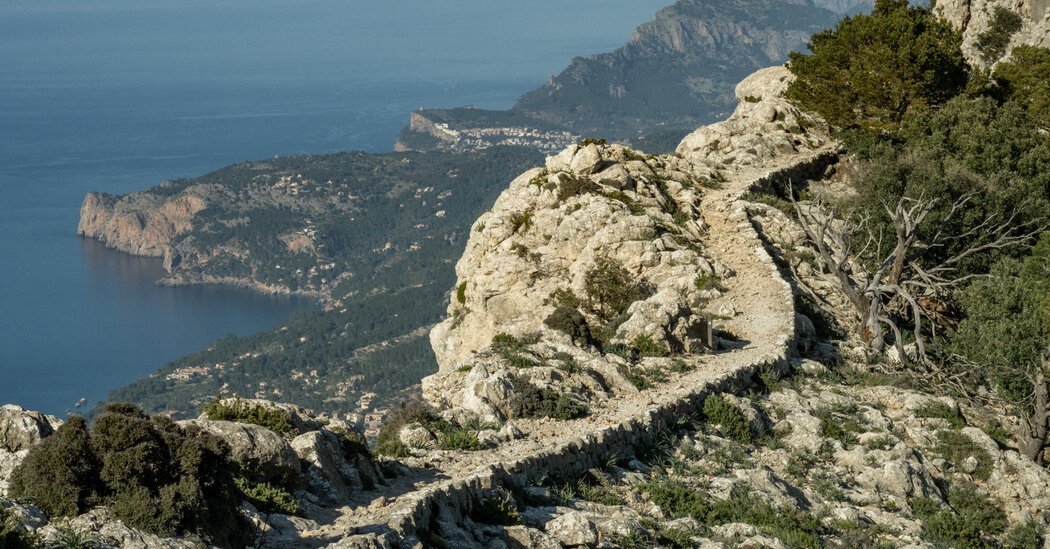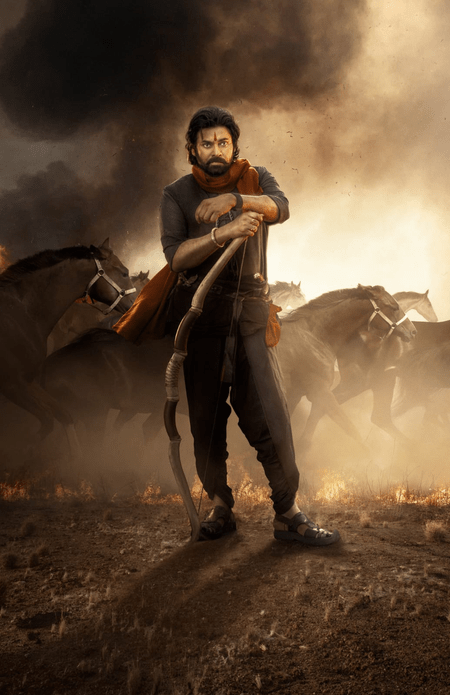
We scrambled around a few boulders, to discover that the trail we had been following topped out on an expansive ridge. After climbing 2,500-feet over 2.5 miles, we paused to admire the view, the rock to our right dropping off to the ocean far below.
Then the trail turned to the left, and we could see the rolling path cut across limestone and dolomite outcroppings winding around wild rosemary, asparagus albus and other sharp shrubs. Out in the distance, a few people perched on a large boulder, but otherwise, the trails between Deià and Valldemossa on the north side of Majorca, were empty in early November, and it was still sunny and warm.
Majorca, a Spanish island in the Mediterranean, is a popular summer destination, especially the capital city of Palma, which is known for its vibrant nightlife. But the island’s northwestern zone offers a dream off-season destination for cyclists, runners and hikers. From April through May and mid-September to early November, prices are affordable; towns are quiet, and the trails and roads are wide open. Public transit around the island is excellent, facilitating point-to-point adventures.
Majorca is also a great destination for solo travelers because the island is small, and the trails are safe and well-traveled, even during off-season.
Away from Palma, smaller towns like Sóller, Port de Sóller, Port de Pollença and Valldemossa have a warm atmosphere with excellent restaurants and access to stellar trails and bike routes, especially around the Serra de Tramuntana mountains. The rugged mountain range — a UNESCO world heritage site — cuts 55 miles across Majorca’s northwest coast, and you climb quickly from the beach into high desert mountainous terrain.
The ocean surrounding Majorca is clear and temperate — in part thanks to Posidonia oceanica (Neptune grass), an endemic sea grass that helps filter the water. The deep sea cliffs are popular for deep water free-soloing, and on the trails, you see pine trees growing out of rock, mixed with groves of olive and citrus trees, with formerly domesticated goats roaming the hillsides.
Sóller, a Home Base for Hikers
Sóller sits in a valley at the foot of the Tramuntana mountains, with some of the range’s highest peaks just out the door. If you’re planning to stay in one town, Sóller is a good home base. We stayed at Lluna Aqua, a quiet hotel in the town’s center (from 119 euros a night or about $135).
To get acquainted with the area on the first day, we chose a section of the GR 221 — a 75-mile-long route across the Serra de Tramuntana — from Sóller to the coastal town of Port de Sóller. The route we did is about six miles one way, with 900 feet of elevation gain.
Once we reached the seaside town, restaurants lined the port, including Patiki Beach, which offers local tapas and fresh caught fish daily (20€ to 30€ per person); Es Canyis, another local favorite serving paella and other classic dishes (25€ to 35€ per person), and Miga de Nube, a more casual breakfast and lunch spot with coffee, smoothies, salads and toasts (10€ to 20€ person). All of these restaurants have large patios facing the port. After a swim in the Mediterranean and lunch, we hopped on the old-fashioned train for a scenic ride back to Sóller.
One of the benefits of off-season travel is that most of the restaurants have space for walk-ins, and we ate out every night with no reservations. In Sóller, we went to La Romaguera for dinner, an upscale but still affordable tapas restaurant (30€ per person without drinks). I recommend the grilled artichokes, the ceviche and the scallops.
We got up early the next day to run a loop to Puig de l’Ofre on a different section of the GR 221 trail, which several locals recommended, picking up pastries from Forn de Barri — a small bakery with excellent almond croissants, focaccia and sandwiches for about 5€— for the day out. The loop started out on pavement, climbing through citrus and olive orchards past the town of Fornalutx, then veering off onto a steep, narrow trail that climbed up along a ravine for several miles before opening to a wide, rocky ridge, from which we could either take one of the dirt roads or trails back down, or scramble to the summit, which required some bushwhacking, but the views were worth it.
The descent to Sóller is less steep than the climb, but the majority of it is on ancient uneven stone steps and cobblestones, part of the historic Ruta de Pedra en Sec, or the “Dry Stone Route,” which traverses the whole Serra de Tramuntana mountain range.
Once back in Sóller after four hours on the trails, we wandered through the town’s small, winding streets, stopping for gelato at Ca’n Pau and sitting on the square at the steps of the 13th century San Bartholomew church. For dinner, we had housemade lasagna at Ca’n Llimona, a tiny Italian place that looks more like my grandparents’ cottage than a traditional restaurant (20€ to 30€ per person).
Cycling: Hairpin Turns and Rolling Hills
There’s a reason many elite cyclists spend their winters in Majorca: The weather is mild year-round, and the steep climbs and descents create the perfect training ground. But you don’t need to be a Tour de France caliber rider to enjoy the island’s scenic roads. From Sóller, you can take on some of the most popular climbs on the island or cruise along the coast on more rolling terrain.
We rented bikes from Kilometro Cero (starting at 40€ a day for both regular road bikes and e-bikes) to tackle one of the most iconic routes on Majorca: riding over Puig Major, the island’s highest point, to the switchbacks of Sa Calobra.
The summit of Puig Major is in a military zone, so you can’t reach the peak, but you still get almost 2,000 feet of climbing from Sóller to the road’s highest point. From there, a steep descent followed by several rolling climbs brought us to the top of the switchbacks. Surrounded by limestone cliffs, we could see the sparkling turquoise ocean far below. The road descending to the sea is breathtaking, but it is not for the faint of heart. The 26 hairpin turns plunge 2,200 feet to a small hamlet, passing through a natural rock tunnel, and the only way out is back up again.
I descended carefully, especially with the wind blowing sideways on the full 270 degree bend of one of the first switchbacks. I knew I had the long climb up to admire the views. In Sa Calobra, we stopped for ice cream bars and Coke, stepping around dozens of cats lying on the warm stones and roaming around outside Es Port, a casual restaurant with a terrace overlooking the cove (5€ to 15€), before starting the long climb back up.
Exploring Monasteries and Coastal Roads
The hilltop village of Valldemossa offers similar vibes to Sóller, although it is farther away from some of the big cycling climbs. The town is probably most known for Real Cartuja, the old Carthusian monastery that today houses several museums, including the apartment where Frédéric Chopin and George Sand lived in the winter of 1838 to 1839.
For hiking and running, Puig des Teix is the most popular summit in the area, which can be done in a 7.5-mile loop from town with 2,300 feet of elevation gain. For a long day out in the mountains, we took a different section of the GR 221 from Port de Sóller to Valledemossa (14 miles, 4,800 feet of elevation). For a shorter route, you can also start or finish in the small coastal town of Deià, on a hilltop near the base of Puig des Teix, which has spectacular views of both the Mediterranean and the mountains. The English writer Robert Graves lived in Deià for years and is buried there.
For a cycling focused trip, the town of Port de Pollença is another good option. After several days in Sóller, we spent two nights in Port de Pollença, staying at Hoposa Montelin (starting at 150€ a night) — a hotel that also has a bike repair and rental shop and a separate garage for bike storage.
From Port de Pollença, we rode to the other side of the Tramuntana mountains over Coll de Sa Batalla and looped back to the 13th century Lluc Monastery, considered the most important pilgrimage site on the island. On the first weekend in August every year, there is a night walk from Palma to the monastery, covering 30 miles.
After a morning on bikes, we had lunch in Port de Pollença at Stay, a boardwalk restaurant on the bay (15€ to 30€ per person). The couple at the table next to us said that the restaurant was impossible to get into during the summer, but in early November, it was quiet enough that the waiters did not mind us spending several hours reading in the sun with coffee. For dinner, we went to amazO, a Spanish and South American restaurant decorated with metallic statues of elephants, leopards and monkeys and a limited daily menu (22€ per person for a starter, main and dessert). I chose the green salad, roasted sea bass and crème brûlée, which were all excellent.
Our last morning, we rode a 30-mile out-and-back route to the Formentor Lighthouse, with panoramic views of the Mediterranean and switchbacks climbing along high limestone cliffs. We got arepas at Mi Querencia Karen for lunch (10€) before taking a taxi to the airport.
If you stay in Port de Pollença and don’t want to ride, Cala Boquer is a three-mile round trip hike to a small, secluded cove. The trail is relatively flat before it dips to a pebble beach for the last section. The waters here are relatively calm and perfect for swimming.





